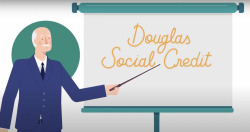Over the past year and a half, twenty-two new videos - all professionally animated - have recently been made available. These videos explore various key aspects of Douglas Social Credit. Please subscribe, like, and pass these videos on to anyone who may be interested. They are currently available on youtube, rumble, brighteon, and bitchute.
https://www.youtube.com/channel/UCDyKdP7Wy-8Fgl3lCUFe2qg
https://rumble.com/c/c-1018734
https://www.brighteon.com/channels/dsc123
https://www.bitchute.com/channel/ybHW5D2vxvW2/




